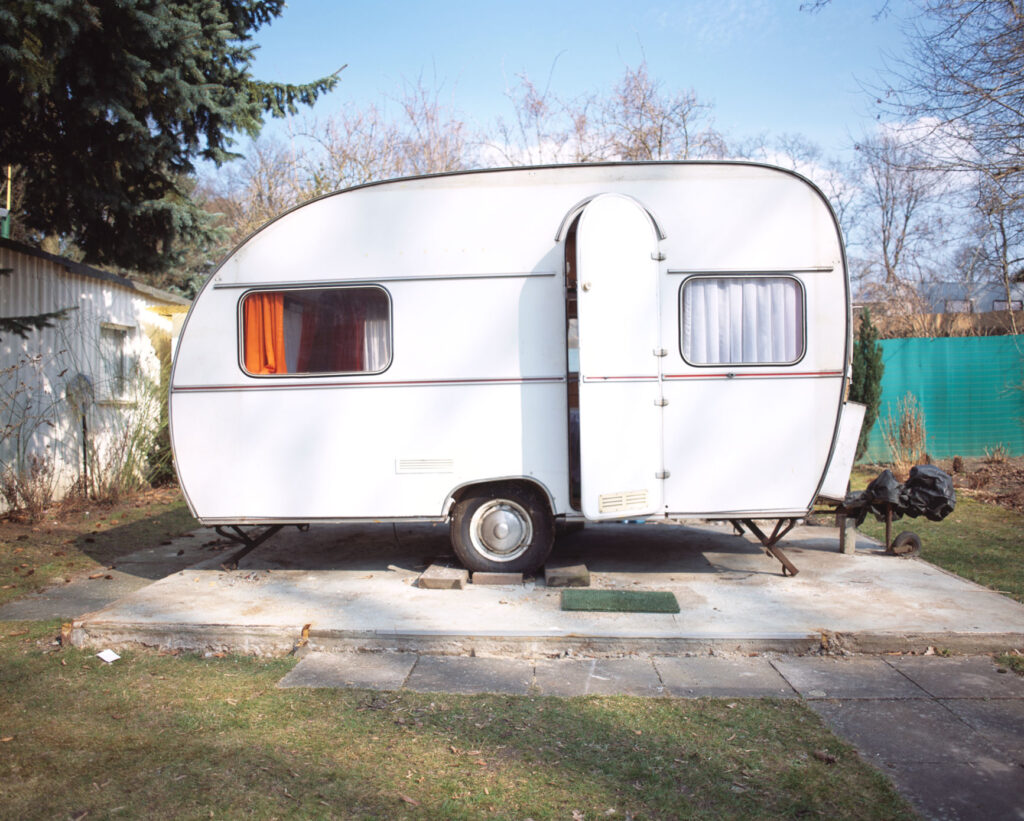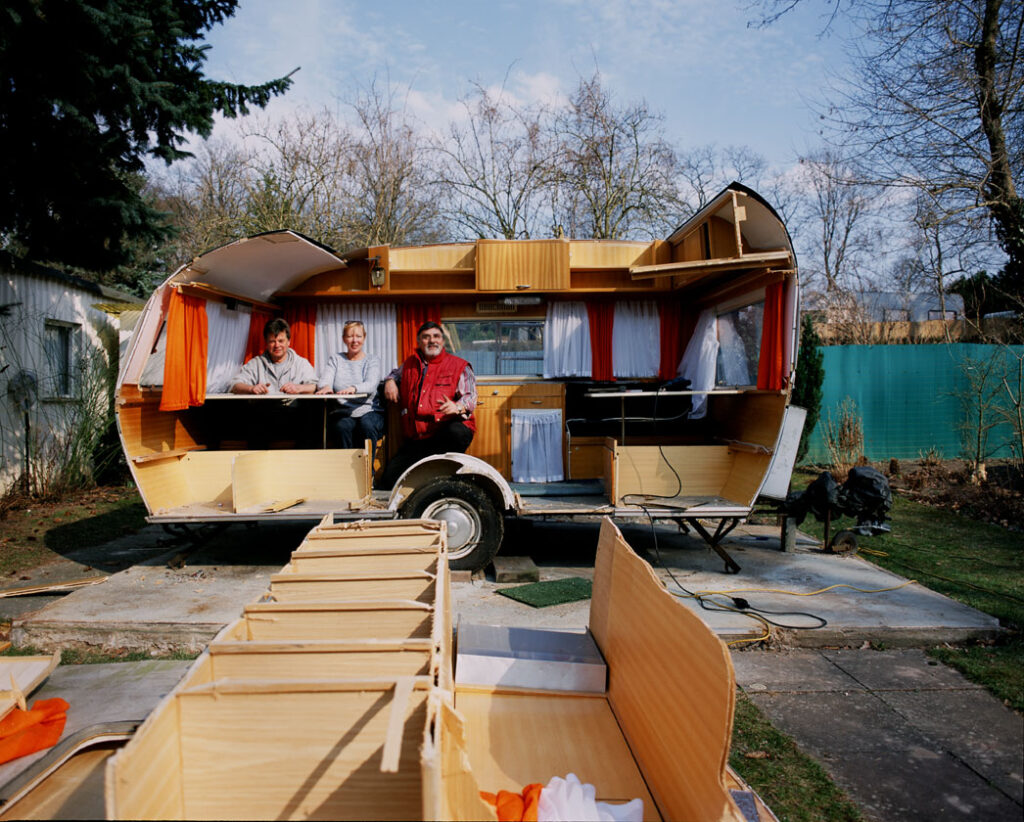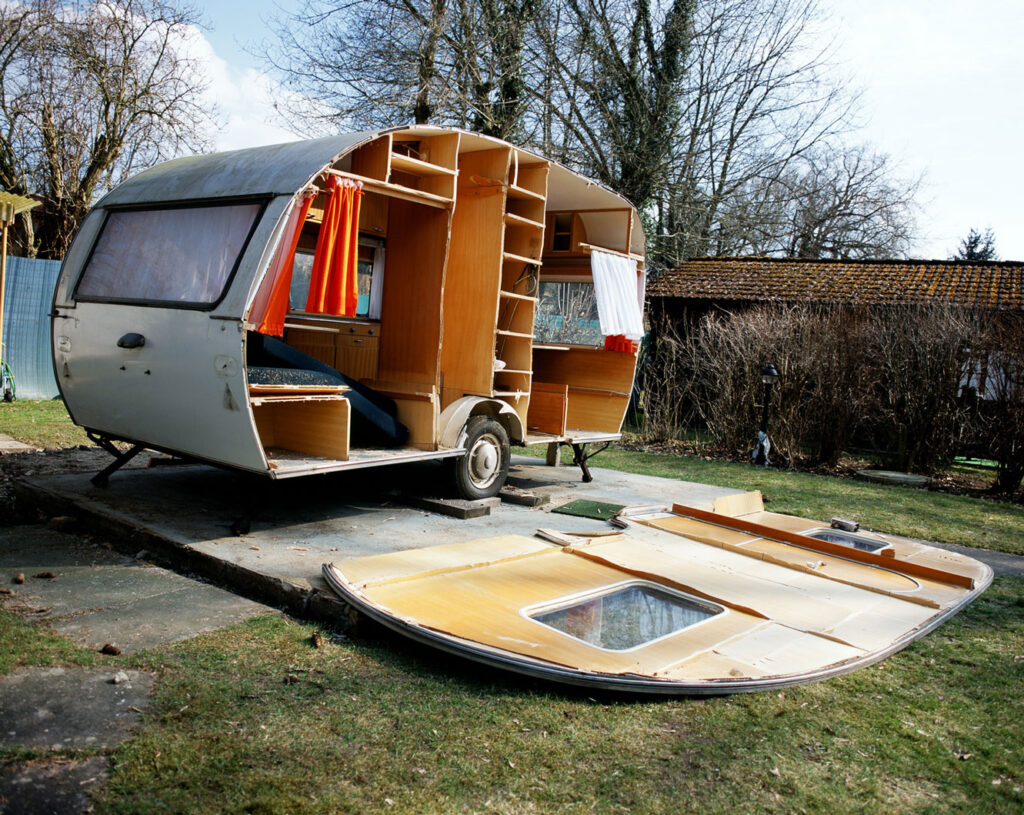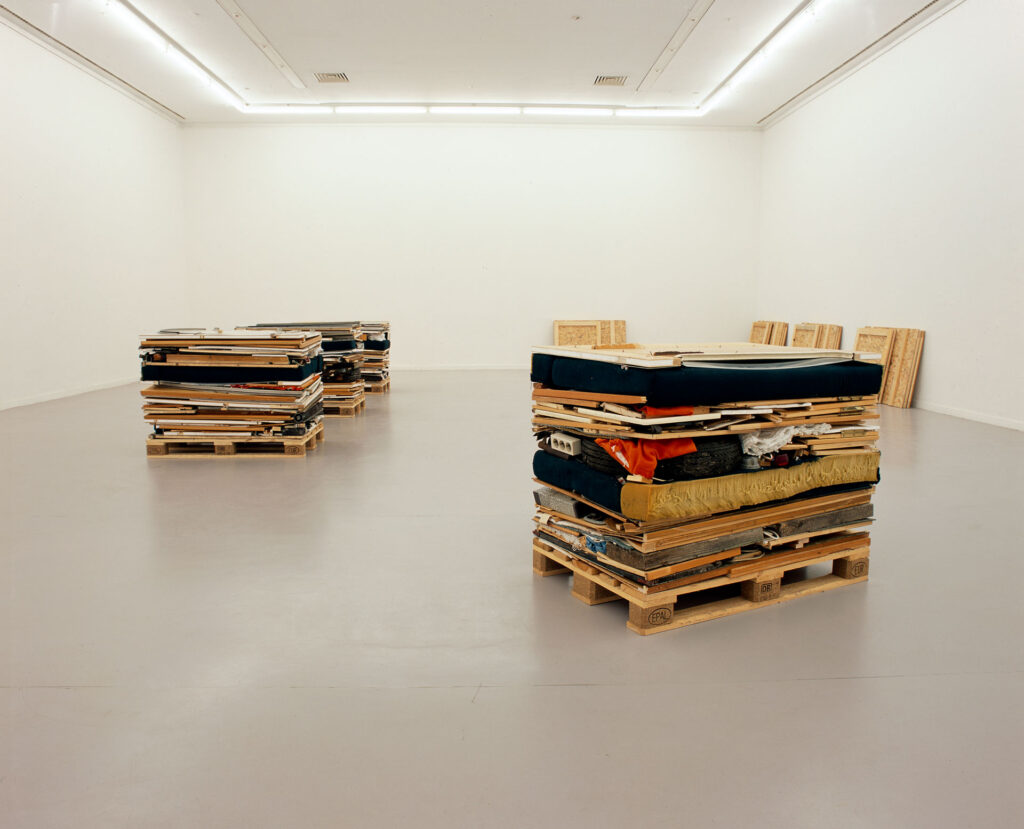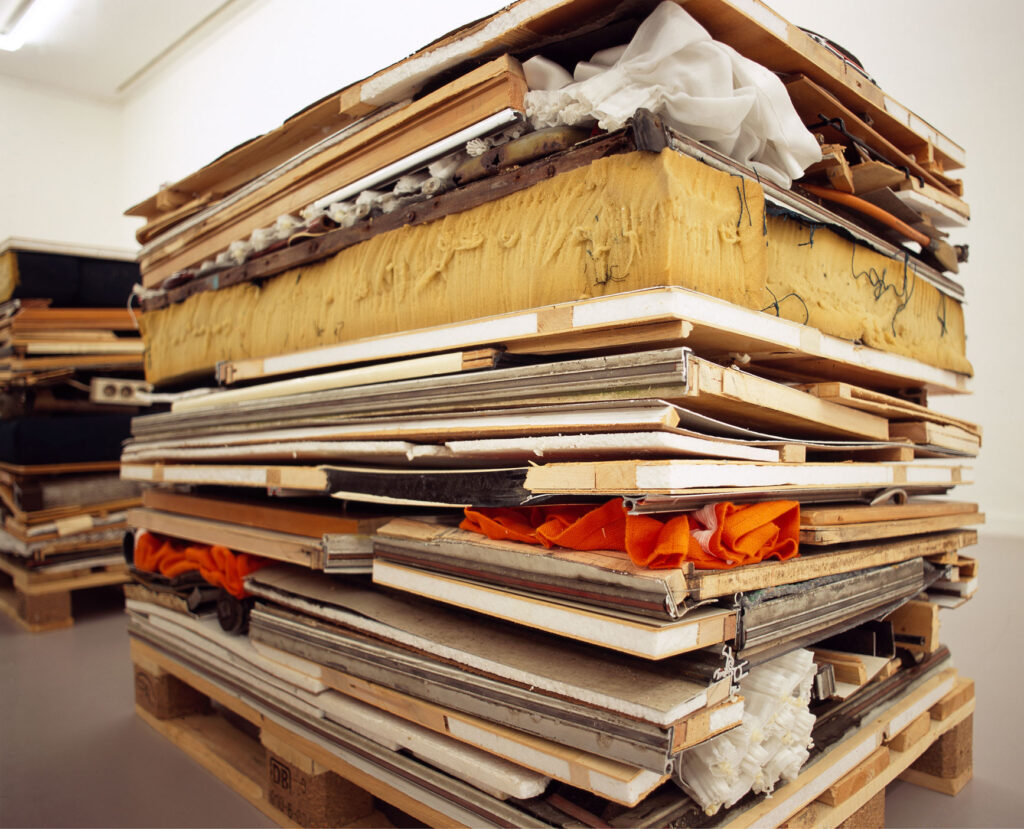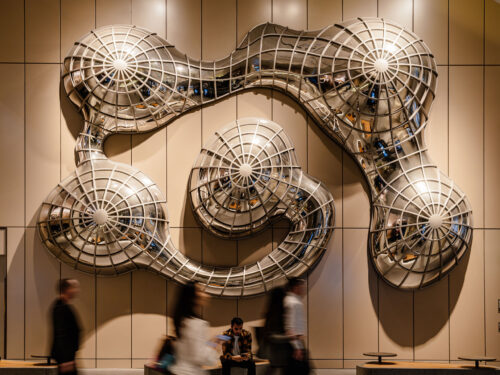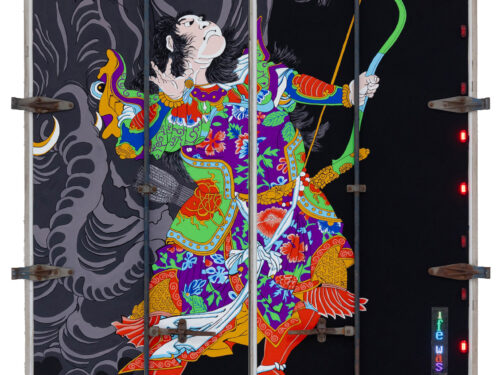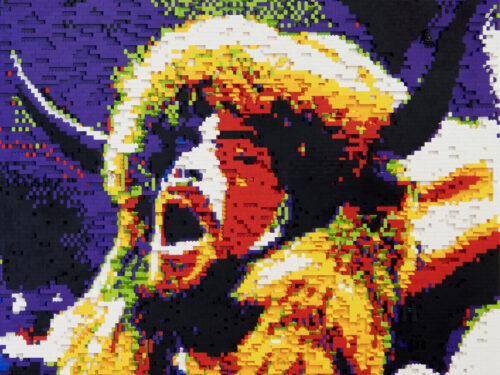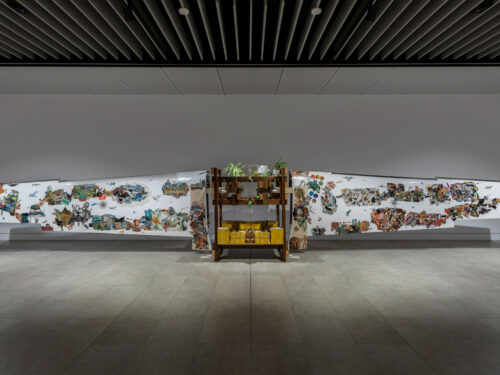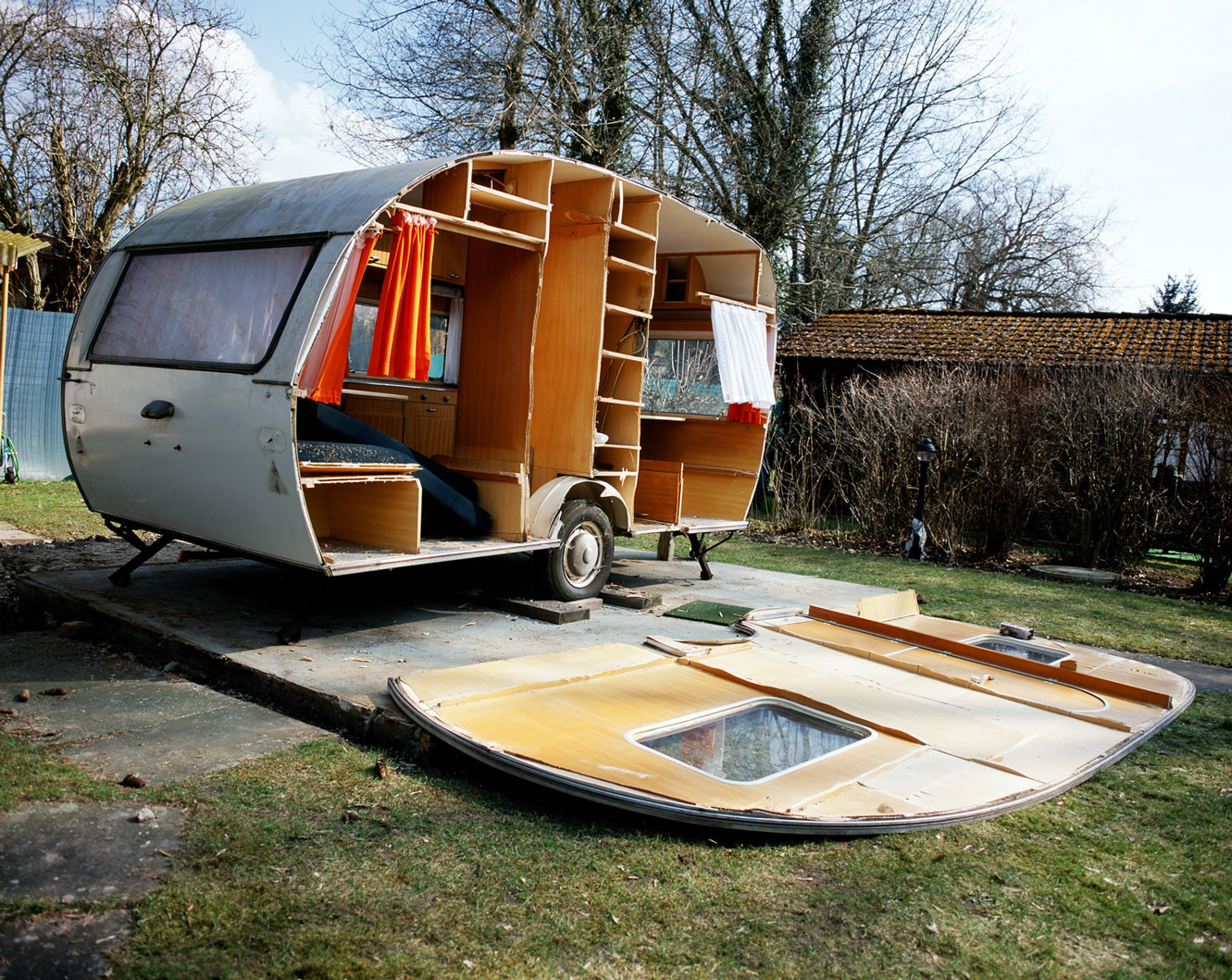
flatpack
There is a Life After the Trailer Park On Claire Healy and Sean Cordeiro’s flatpack
It’s the same in art as otherwise in life: something else is usually behind the things one sees at first glance. Four meticulous stacks stand in Berlin’s Künstlerhaus Bethanien: equally broad, equally long, equally high, in the middle of the exhibition room and arranged so that a person can just barely pass between them.The work that Claire Healy and Sean Cordeiro built up here in May 2006 seems rigorous and reduced. The form and rela- tionship with the room suggest a kinship with minimal- ist sculptures. But it soon becomes clear that things are different here. The piles are stacked within centimeter tolerances with diverse materials: plastic and metal, for example, wood veneer, textiles, rubber, and gauze. And everything bears traces of weathering, years of use, and the tools that cut up all the material. Now the brown, beige, white, gray, and orange fragments stack up on four Europa palettes, ready for transport. A few shoves would suffice to turn the piles into what they are: four cubic meters of bulky refuse. Hard to believe that this was once a trailer.
Of course the trailer has a history. An older lady is sup- posed to have lived in it for 40 years, until it grew old and leaked rain.The two artists found the trailer during Healy’s Berlin stipend from the Australia Council for the Arts: out in Kladow, a suburb of Berlin just before the former border strip where the Berlin Wall used to divide West Berlin from the territory of East Germany. Kladow has little to do with today’s reunited Berlin, with new
government buildings, embassies, and the club and art scene.The islands out in the Havel River in front of the center of the village of Kladow are a nature preserve; upstream, campers have parked their trailers between a manor park and the sewage plant.
But this history is not the point at all. Healy and Cordeiro have cut up the old lady’s home with a backhand saw, circular saws, and metal saws. Now the frame lies under a piece of wall; the curtain, still on its rod, is crushed by boards. Healy and Cordeiro have aptly named their instal- lation flatpack. Unlike the huge castings of apartments by British sculptor Rachel Whiteread, to which Healy and Cordeiro’s works are sometimes compared, the narrative of life falls silent here: the details that could report on the resident’s daily life disappear in the stacks.
Travel Faster
On the other hand, the history of the trailer does matter. None other than two artists who are constantly on the move, who in 2003 alone saw 14 countries on 3 conti- nents during a travel stipend, have taken apart a trailer that served someone as a home for four decades. That is a striking contrast – and congruent at the same time. The old lady herself had already robbed the trailer of its original function: she didn’t travel with it. And she obvi- ously no more dreamed of getting away from home by hanging it onto a car than the artist couple, who board the plane with as few personal possessions as possible. That Healy and Cordeiro have destroyed the trailer could seem almost coldly consistent. But as a matter of fact, here the artists adjust the outmoded form of mobility represented by the trailer to current standards. Today,
no one travels with the traditional house trailer except if they have time and no long-distance destination. But taken apart and layered on Europa palettes, the trailer is easily put on a forklift and taken to the nearest port or airport and from there anywhere in the world. Healy and Cordeiro’s site-specific investigation of temporary dwelling is thus also an investigation of the perception of the way things go.
flatpack takes the Western linear concept of time as its theme. With the rounded corners and wooden veneer of the trailer, which are still recognizable in the pile, the installation reminds us of the growing affluence of the 1960s.The hunger of the postwar years was allayed; now bigger wishes were on Europe’s list and could be fulfilled by broader segments of the population. Among them were a car of one’s own and trips. Many Germans packed a swimsuit and a camping stove in a house trailer and set off for the South. A long time ago. The trailer has been replaced by the faster mobile home and by family vans that, loaded with surfboards and bicycles, take the holi- day-maker to vacation homes with Internet connections. The trailer, by contrast, has deteriorated into a symbol of the petit bourgeoisie who always camp at the same lake or of the working conditions of the residents of North American trailer parks, who often have to follow poorly paid jobs around. It’s no longer even good enough for critics of mainstream traveling and dwelling. Nowadays, adventurers travel by bicycle or foot again; those who live in circled wagons prefer the proletarian flair of the construction trailer. Much has changed in the 40 years the lady spent living in her camping trailer.
But the popular stories of the course of history are de- ceptive. Things do not change in a linear manner and not all of them at the same speed. While the automobile industry was putting new types of vehicles on the mar- ket and the airplane brought distant destinations close, while Berlin was turning into an international city of cul- ture, the old trailer in Kladow simply did its job. Healy and Cordeiro say they always experienced the passage of time more consciously in the country than in the big cities. Things are reversed with flatpack. By bringing the vehicle from its tranquility in Kladow to the center of Berlin, the artists tear a vintage vehicle from its stand- still and contrast the patina of its material with the rapid changes of the inner city. The work recalls a life that hardly appears in the current narratives about Berlin, but which nonetheless exists. It thus also takes up the theme of the simultaneity of life designs that historiog- raphy assigns to different epochs.
What Remains of Life
Healy and Cordeiro investigate houses and homes as private spaces in which the public and social are dealt with. They question the status that collective memory assigns to these sites and the people living in them.They have already deconstructed a home once before to make its social and economic context visible. For The Cordial Home Project in 2003, they took apart a condemned wooden house in a suburb of Sydney and stacked the material between four bearing beams of the exhibition room. What reminded some viewers of the works of the artist Gordon Matta-Clark, however, was not criticism of architecture, but an intervention leading to a site-spe-
cific installation, a collective act in which some 40 help- ers took part – friends, experts, and family. In the end, The Cordial Home Project distinguished between several kinds of values that such a suburban home can have: the monetary value, the emotional value, and the value or lack of value attributed to the house in the gentrified suburb. flatpack, too, deals with values. It is not known whether its erstwhile resident still feels attached to her trailer. Too new to be considered an antique, it would have brought no price on the market. On the contrary: having it removed as scrap would cost money.
So what remains of life when a person gives up the place he lives in? Plenty of refuse, is Healy and Cordeiro’s sobering conclusion. On their journeys they have expe- rienced it often enough and also taken it as a theme in some works.Thus, a few months before flatpack was cre- ated, Sean Cordeiro flew to Tokyo for a 3-month work residency, later to be followed by Claire Healy. In the stipend studio there, they found useless legacies of their predecessors: books, hand towels, bottles, cans, boxes, and a guitar with no strings. Cordeiro and Healy stacked them up to make a wall-filling installation that can now be seen on the invitation card to the Berlin showing. In Weil am Rhine, Germany, Healy and Cordeiro bundled the garbage found in an abandoned studio into a huge ball, drastically illustrating the contradiction between the material affluence and the uncertain income of artists in Western societies. A contradiction that is becoming relevant for ever larger groups of people: a precarious occupational existence confronts a wealth of things and commodities. Both are the results of a globalized capi- talism that seeks to create demand by oversupplying, but
which makes wages and jobs uncertain with cheap pro- duction costs and which endangers national economies by neglecting to use resources sustainably. Healy and Cordeiro counter these contradictions by acquiring as little as possible, in that they use material found on site instead of adding further objects to the flood of things, by upcycling refuse to art and thus making the material and immaterial value of the raw materials visible.
But however little refuse Healy and Cordeiro leave be- hind them where they have stayed, no matter how little they buy in order to keep moving without ballast: the social and economic patterns travel with them. The way a person arranges his laptop in a new place, they way he sets the table, already helps determine how he works and what his social relationships are. Healy and Cord- eiro are sending works from Berlin to Australia for their next exhibition. Garbage from Germany travels halfway around the world. Ecologically, it is terrible nonsense, says Claire Healy. But that’s what the rules of the art business demand. A similar work, created from local ma- terials in Sydney in accordance with a concept, would be in a different genre and would be received and assessed differently.
It seems as if people remain prisoners of their rules. Stuck like a trailer in the mud, its wheels spinning. But even after 40 years in the trailer park, movement is pos- sible. The end of the Kladow trailer also stands for the hopeful beginning of a new phase of life: the old lady, Healy and Cordeiro were told, has moved to her love in southern Germany.
Claudia Wahjudi
